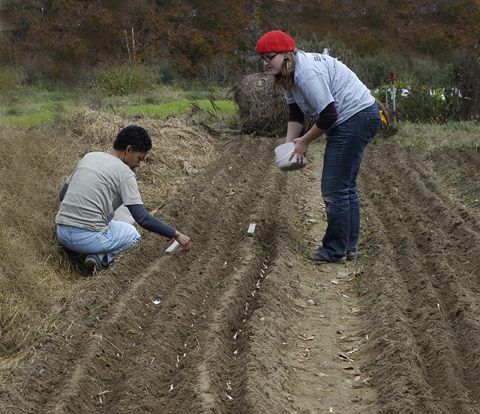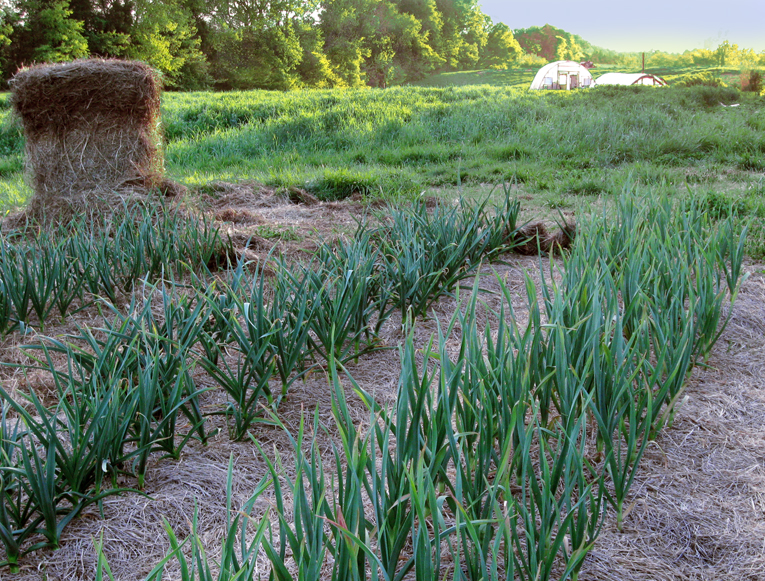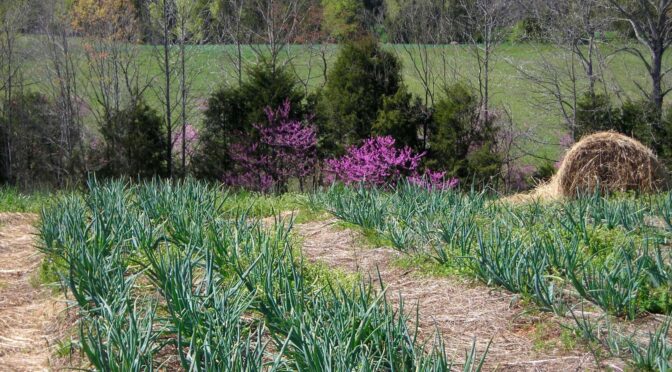Every vegetable patch needs a section for garlic! Garlic offers tons of flavor with minimal effort. It’s an excellent option for beginners because it’s pretty easy to grow, takes up relatively little space, stores well, and is easy to save from year to year. Once you buy garlic, you won’t need to purchase it again. Raised beds are often the preferred choice for growing garlic, but they aren’t your only option. In this post, we’ll dig into garlic’s soil requirements and why you may or may not want to install raised beds.
Garlic Soil Requirements
Soil structure is the most important feature to consider when growing garlic. The roots need as much air as they need water. Garlic performs best, forming the largest bulbs, in loose, well-drained soil. Sandy loam is ideal, but few people are blessed with soil like this.
If you’re working with heavy clay or sand, the best thing you can do is work plenty of organic matter into your beds. Add compost, well-aged manure, peat moss, rotted-down sawdust, or a combination. Growing a cover crop in your bed before planting garlic is another great method for building soil structure.
If you haven’t done so already, a soil test can be helpful for garlic and all your other crops. Garlic and onions prefer a relatively neutral pH between 6.5 to 7.0. Soil outside this range that is too acidic or too alkaline will slow garlic’s growth and cause late maturity.
See more about amending soil and signs of nutrient deficiencies in our full garlic growing guide.

Raised Beds for Garlic Pros and Cons
Building raised beds is one solution to quickly provide good soil for garlic. There are a few pros and cons you should consider before you begin.
Raised Beds for Garlic Pros
- Raised beds quickly provide excellent, deep, loose soil for garlic.
- They warm up quickly in the spring.
- Raised beds usually drain well.
- Raised beds are generally easy to maintain and may help lessen weed pressure.
Raised Beds for Garlic Cons
- Bringing in soil, compost, and/or building materials can be costly.
- Raised beds may dry out more quickly and need watering during the summer.
- Eventually, raised beds may need to be repaired or replaced.
Traditional Beds for Garlic Pros and Cons
It’s also perfectly acceptable to grow garlic right in the ground in a traditional garden bed. Like raised beds, this method comes with its pros and cons.
Traditional Beds for Garlic Pros
- No construction is needed, and you won’t have to repair or maintain raised beds.
- Traditional beds are easy to till.
- Traditional beds are easy to incorporate into large irrigation or watering systems.
Traditional Beds for Garlic Cons
- They may have dense clay soil or nutrient-poor sandy soil that may take a while to amend.
- Traditional beds tend to have poorer drainage and may stay wet in the spring.
- Traditional beds may be more susceptible to erosion and weed pressure.
How to Design Raised Beds for Garlic
If you’ve decided that raised beds are right for you, it’s time to start planning. Generally, it’s a good idea to lay things out on paper before you begin construction.
Ideally, raised beds should be at least 12 inches deep. Their length doesn’t matter, though you may want to break one long bed into a few smaller ones to create working pathways. Their width is also a personal choice, but you should be able to easily reach into the middle of the bed to weed, plant, and harvest without standing in it. Many folks create beds 3 to 4 feet wide for this reason.
You also want to think about the location of your raised beds. Ensure they get plenty of sunlight and are within reach of your garden hose or irrigation system.
If you’re building multiple raised beds or placing them near other structures, it’s also a good idea to leave pathways around your beds that are at least wide enough to fit a wheelbarrow.
Remember that plant roots will often grow deeper than your raised bed. Don’t place a raised bed on any area contaminated with chemicals.
Once you’ve got a plan, you can frame up your raised beds. You can make raised beds from logs, rot-resistant lumber like black locust or cedar, stones, bricks, or blocks. Avoid using tires, pressure-treated lumber, or any materials that could leach chemicals into your food-producing beds. Depending on the material you use, corners can be held together with stakes, plumbing straps, or screws.
Fill your beds with good quality soil and compost or just finished compost. You will need more material than you think as it will settle. You should fill at least 12 inches deep with compost or good soil. Adding compost to the bed each year is also a good idea.
How to Design Traditional Beds for Garlic
While some gardeners prefer raised beds, many growers still find plenty of success growing garlic in the field. If you decide this is the best method for you, there are a few things to consider when preparing your beds.
Garlic hates to have soggy feet. If you have space to work with, always locate beds for garlic and other alliums in your highest or best-draining areas. Low spots that stay consistently wet through the spring and early summer will make for a poor harvest.
Prepare your beds by adding plenty of organic matter either through cover cropping ahead of time or working in compost, peat moss, old rotted sawdust, or aged manure. As mentioned above, a soil test and any necessary amendments are also a good idea whether you need to change the pH or increase fertility.
Many people choose to till new beds, but you can also loosen the soil with a broad fork or garden fork for a no-till option. This is also a good choice for gardeners working in small spaces. Forks allow you to lift and loosen the soil without turning it over.

Garlic Growing Tips
Garlic is generally an easy keeper, but there are a few things to remember that can improve your harvest.
- Water garlic consistently if you don’t have much rainfall during its spring and summer growing period.
- Garlic doesn’t compete well with weeds. Keep your patch well-weeded for the biggest bulbs.
- Select an appropriate type of garlic for your garden and climate zone.
- Plant your garlic at the proper depth and spacing.
- Mulch garlic well with old leaves, straw, or hay.
- If you’re growing hardneck or Asiatic garlic, remove the scapes when they’re eating stage for the best bulb production.
- Use a garden fork to gently harvest bulbs and cure and store them properly.

